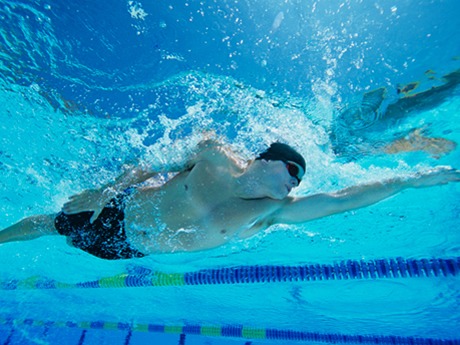
Welcome to the Endurance Nation Short Course Triathlon Series, created to support our 2017 Short Course Triathlon Training Plans.
These 12 week Short Course Triathlon Training Plans are FREE for a limited time! Go here to learn more and gain instant access to your training plan today!
In the first installment of the series, we discussed training fundamentals for short course triathlon, big picture guidance to help you understand the intent and organization of our short course triathlon training plans.
In this second installment we now turn towards how to train for the short course triathlon swim, usually a distance of about 700 meters/yards for sprint distance events, and 1.5km / 1 mile for Olympic distance events.
Fitness Applied to Technique
This is a typical scenario a triathlete may encounter at a pool session:
- Getting Killed by an 10 Year Old: you’re lean, fit, have all the pool toys, doing your thing in lane 1…but the kids in their swim practice on the other side of the pool are absolutely crushing you. They’re so much faster!
- Getting Smoked by the 60yr Old: then, in lane 2, you see a 60yr old portly gent swimming effortlessly and much faster than you.
What’s going on here?!
The fundamental characteristic of all triathlon swimming, particularly for “adult onset” swimmers, is that it’s a technique-centric sport. That is, you’re only as fast as your technique and your ability to maintain that technique for greater and greater distances. The 10yr old and the 60yr old are faster than you because they likely have years and years of swimming, and swimming technique work, in the bank. The time they’ve spent learning the fundamentals of proper swimming form have created excellent technique, and then time in the pool builds the fitness to sustain that technique for lap after lap. The net result is a smoothness and speed that can be maddening for the adult onset swimming triathlete, frustrated that cycling and running fitness simply doesn’t translate well to speed in the pool.
So how does this fundamental characteristic of triathlon swimming express itself in terms of training for the swim?
Seek Quality One-on-One Swim Instruction
The most valuable time you can spend in the pool is under the observation and guidance of an instructor who can give you quality feedback, and a prescription of drills to help you address technique issues that you apply across a focused, 4-6 week block of swim training. For example:
- Book several technique sessions with this coach, as many as you can afford, frankly, or have time for. Ideally the coach will be able to give you underwater video, with critiques, of your swimming form, and a prescription of drills to do before your next session. Bonus if the coach can write swim workouts for you that will incorporate these drills.
- Do ^these^ workouts and drills 2-3 times each week before your next technique session.
- Meet your coach for another technique session, assess your gains and opportunities for improvement, and repeat the process.
Remember…you’re learning to play a musical instrument and the most time efficient method to do this is with quality one-on-one instruction.
Swim Only as Far or Fast as Your Technique Allows
Now that you’ve begun to address proper technique, let’s next discuss how you should structure your fitness-building swim workouts. Consider:
- At some pace / effort, your form begins to fall apart. That is, when you swim at an easy and comfortable effort your technique is great. But when you try to swim much faster, everything starts to fall apart rapidly.
- Likewise, after some distance your form also starts to fall apart. In this easy swimming example above, you do great up to about 400 yards and then your lack of swimming endurance expresses itself as compromised form…and it just gets worse and worse from there.
- Finally, if you don’t get enough recovery between intervals, you become less and less able to maintain your proper form.
For much of your swim season we only want you swimming as fast, as far, or with enough recovery so that you’re swimming as much as possible with your best form possible.
For example, your workout calls for 5 x 400 yards at a 1:45 per 100 yard pace, taking 30 seconds rest between each 400. A 1:50 pace would be more comfortable for you but you want to push yourself to hold 1:45’s. However, at about the 300yd mark your arms feel like rubber, you’re gasping for air, and, even worse, your form completely falls apart. What do you do?
Rather than continue to do the workout you thought you were going to do, which will only serve to increase the muscle memory of poor form, you should drop the 400’s down to 300’s, or even 250’s, and keep pushing the 1:45 pace as long as your technique is still good. You may even want to take a bit more rest between each repeat, so you can continue to swim faster with your best form.
The net is this: it’s better to swim shorter, faster, with excellent form, and more rest, than to slog away at longer intervals, slowly, with poor form. You then simply get the volume of swimming you need by swimming more of these shorter, harder, good technique intervals.
Don’t worry, as your fitness and endurance build you’ll be able to swim for longer and longer intervals…but longer isn’t necessarily better. In fact, generations of very good competitive distance swimmers have been created through a healthy diet of 200-500yd repeats.
Stay tuned for Part III: Short Course Triathlon Bike Training, and in the meantime go here to pick up your FREE Endurance Nation Short Course Triathlon Training Plan!


Leave a Reply